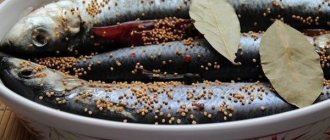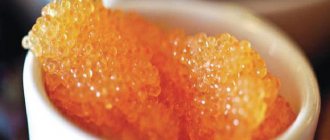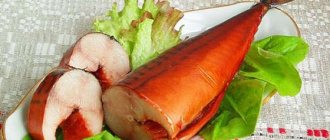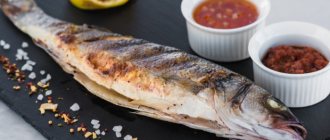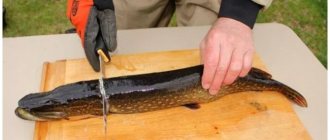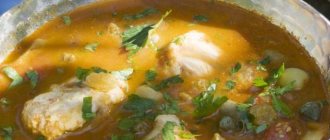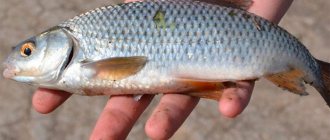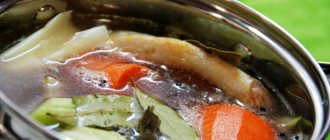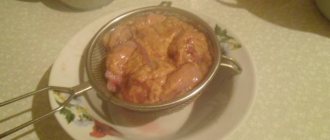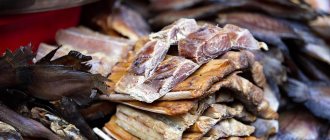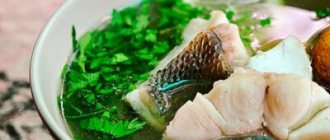Yuri 09/08/2020 1116
The pike is in the river so that the crucian carp does not sleep - says a Russian proverb. What to do if the main fisherman in the family returns with an unprecedented catch? It is possible that the “hunter” simply bought the fish in the store so as not to lose face. But this doesn’t change the situation: something needs to be done with all this goodness. From pike you can make rich fish soup, fish cutlets, bake in the oven with vegetables and fresh herbs - there are a lot of options for preparing fish. But here’s the problem: when her husband arrived, the hostess had cooked borscht and fried juicy cutlets.
What to do with live fish so that it does not disappear? The best option is to salt the pike. And not just sprinkle with salt, but salt with feeling, sense and order.
Detailed salting process
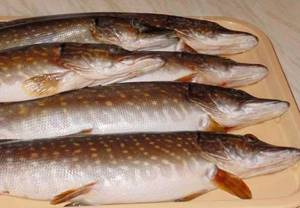
First you need to prepare the fish for salting, rinse it thoroughly and trim off the excess parts. These include the head, tail and fins. The pike's entrails are also removed. When doing this, be careful not to damage the gallbladder. After this, the carcass is cut up by removing the ridge through a cut on the back.
To remove any remaining entrails from the carcass, use a napkin. It is better not to wash the inside of the fish with water.
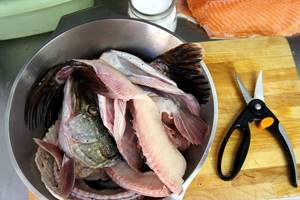
Required ingredients:
- carnation;
- black or red pepper;
- Bay leaf;
- 7 tablespoons of coarse salt per 1.5 kg of pike;
- rosemary.
Before salting pike, you need to mix all the prepared ingredients, namely salt and seasonings. The carcass needs to be rubbed with spices inside and out. If you cut it into pieces, the salting process will go faster.
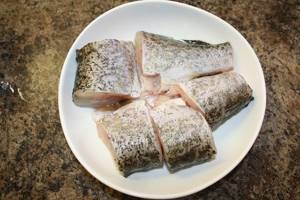
The fish is placed in a prepared container, pressed with a weight on top. Don't forget to add bay leaf. If the pressure is heavy, the pike will turn out drier. The pike is kept for 2 days at room temperature, after which the load is removed and the brine is drained.
If you can’t wait to eat salted pike, after two days, remove it from the brine and soak it in cool water. Then you need to remove the skin from the carcass and cut it into pieces, if you have not done this before. The fillet is sprinkled with lemon juice and sprinkled with herbs. Leave the fish to soak for 20 minutes and add pieces of pickled onion.
How to salt pike so that it turns out lightly salted? To do this, reduce the time she is under pressure. Adding vinegar to the brine will protect you from parasites that may be present in the fish. If desired, you can add garlic and other spices.
Salting pike at home - recipes
There are many recipes that can be used for pickling, but we will look at the more popular and less expensive ones.
Dry salting method
This method is easy to make and will help out when you forgot to buy a beer snack.
For implementation, the following ingredients are required:
- Small pike;
- Coarse salt;
- Pepper;
- Seasonings as desired.
How to cook:
- Gut the fish well, rinse and dry;
- If the fish is large, it is recommended to cut it into smaller pieces;
- Rub dry pike with salt, and add seasoning and pepper to the belly;
- If you don’t mind the aroma of garlic and herbs, you can also add it for flavor;
- Place in a pan and cover with a lid of a smaller diameter, placing a brick on top, and place in the basement for 5 days.
After such procedures, the pike can already be eaten; if it is not possible to eat it whole right away, it can be stored for 30 days in a cold room. In order not to confuse the production date, you should attach a sticker with the date of pickling, and after one month, dispose of it.
Wet salting method
One of the wet salting methods will be described step by step below.
Components:
- Pike can be taken of any size, since for this recipe it should be cut into small pieces;
- 0.5 liters of water;
- 4 tablespoons salt.
Cooking method:
- Process the fish and cut into pieces;
- Place in a plastic container and fill with salt water until the fish is covered;
- Place in a cool place for 3 days until completely salted.
Do not worry about a large amount of salt, the pike will not take in more than the norm that it is supposed to.
The secret of the method is the absence of seasonings; salt is enough. This method will be appreciated by all fish lovers, since its unusual taste and aroma will be appropriate both on a festive and on an ordinary table.
Quick salting of pike
An emergency recipe that won't take long to prepare. You must have the following components:
- Medium sized pike;
- 1 liter of clean boiled water;
- 4 tablespoons of coarse salt;
- 1 tablespoon sugar;
- Spices that will be combined with fish;
- 300 grams of apple cider vinegar.
Cooking method:
- Add spices (garlic, cloves, bay leaf), salt and sugar to the water;
- After it boils, add vinegar and mix thoroughly;
- We pre-process the fish and cut it into small pieces that will fit well into the container you are going to use;
- Place fish in layers in a glass bowl and fill with brine;
- We leave it in the refrigerator for 3 hours and then you can eat it; the fish will be juicier if the cooking time is increased to 1 day.
Despite the minimum amount of time, the pike will have a wonderful aroma and no less attractive taste, which will not leave any gourmet indifferent.
Salted pike
Lightly salted pike does not require a lot of salt, but the presence of other seasonings is selected individually; even the most experienced cook will not be able to name the exact amount of spices and salt, so it is recommended to cook according to this recipe and after the fish is ready, make a note in the recipe that it was possible what should be added and what should be removed altogether.
For lightly salted pike you need:
- 0.5 kilograms of pike;
- 200 grams of regular iodized salt;
- 3 tablespoons corn oil;
- 1 tablespoon vinegar;
- Spices.
Cooking process:
- Initially process the fish by removing the tail, head and fins and dry thoroughly;
- Cut the pike into small pieces;
- Sprinkle salt on the fish and shake well;
- Place tightly together in a container and leave for 3 hours;
- After pouring vinegar brine, the pieces should be completely hidden;
- Close the lid and leave again for 3 hours;
- Afterwards, drain the vinegar and add spices to the fish, shake it up and put it in the basement for a day.
Before serving, you can cut the onion into rings and add a little vegetable oil. This method may seem complicated to some, but it's worth it.
Salting pike caviar
An interesting recipe that people almost always throw away.
Required:
- 500 grams of caviar, which must be fresh, otherwise the taste may be bitter;
- 2 tablespoons salt;
- 100 grams of sunflower oil with flavor.
How to cook:
- Rinse the bags of caviar thoroughly;
- Remove the film and place the contents in a bowl, adding salt;
- Stir and remove any foam that may form;
- Add oil and stir;
- Leave in the refrigerator for a day.
This recipe can be prepared both for immediate consumption and for storing in the winter. Fish should definitely be included in the diet of a healthy person at least once a week.
Let's celebrate! Cooking fish dishes has a wide range and can never get boring thanks to the different variations of preparation.
Preparing the dish will not take much time and will bring vitamins and minerals to the body.
Useful properties of pike meat
Fish meat contains a large amount of nutrients.
It includes:
- Protein – which forms the material for muscles and tissues;
- Selenium – increases the level of immunity;
- Omega-3 – helps to establish normal cholesterol levels;
- Vitamins B12 and A – improves skin quality and helps with growth;
- Sulfur – resists harmful bacteria;
- Fish oil – resists the formation of blood clots in blood vessels;
- Phosphorus – strengthens bones and teeth;
- And also cobalt and copper.
Eating pike meat is valued due to the following properties:
- Strengthening blood vessels;
- Prevention of diabetes;
- Saturates the body with vitamins and minerals;
- Fights viruses.
Let's celebrate! In addition, fish meat restores hair and strengthens nail plates. The calorie content of pike depends on the cooking method, so fresh - 90 calories per 100 grams, salted - 103 calories, but smoked - about 170 calories per 100 grams.
To choose the right fish, you should follow these tips:
- The fish should have a pleasant smell, not rotten;
- The surface of the pike should not be sticky or slippery, this indicates improper storage and transportation;
- The eyes should be bright without clouding;
- The body does not retain the hole when pressed, but quickly takes on its previous appearance;
- The scales do not have red spots, and the gills should be red.
Preparing for salting:
- If the fish was frozen, it must be thawed;
- Remove carcasses from bones;
- Remove tail and fins. If the fish was with its head, then it should also be removed;
- Wash in cold water several times until the water becomes light in color without streaks of blood;
- Drain the fish in a colander to remove excess liquid.
Note! This preparation must exist in any recipe, but if the pike is small in size, you can leave it with the head and tail.
How to salt pike for drying
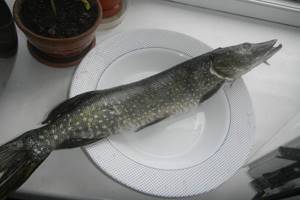
For the salting process, use dishes that do not oxidize. An enamel pan is suitable for this, as well as a plastic or glass container of a suitable size.
If you want to learn how to salt pike for drying so that the dried fish turns out tasty, then take note of these simple tips. It is important to prepare the fish correctly and not make a mistake with the required salt concentration.
Let's start the cooking process:
- The fish is washed thoroughly and the insides are removed, in this case it turns out drier. But if you wish, you don’t have to gut the pike.
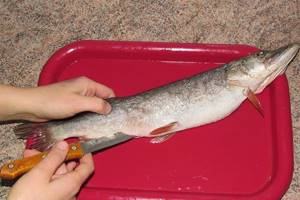
- Prepare an enamel pan of sufficient volume and pour a 1 centimeter layer of salt onto its bottom.
- Place the pike on its side in the pan, and again cover it with a centimeter layer of salt on top. Place all the fish in this manner. Sprinkle the last layer with salt.
- Place a weight in the form of a weight or a container of water on top of the lid so that the fish releases juice.
- Place the pan in a dark place for 2 weeks.
After 2 weeks, the next stage of salting pike at home begins, the recipes for which we provide in this article. After salting, the fish is soaked for 2 days in cold water.
This process occurs as follows:
- The already salted pike is removed from under the load and washed thoroughly.
- After this, it must be lowered into a container with cool water.
- After two days, the fish is taken out and hung to drain off excess liquid. This completes its preparation for drying.
In lemon-mustard marinade
Lemon-mustard marinade can give any fish a piquant taste.
- Wash fresh pike, remove scales, gut it, cut the backbone and lay it flat on the fillet.
- Sprinkle each piece of fillet with coarse salt and sugar.
- Place the fillets in a non-metallic container, press down with pressure and leave for 48 hours.
- Wrap each fillet in cling film and place in the freezer for at least 2 weeks.
- After 2 weeks, remove the required amount of prepared fillet from the freezer and let it thaw slightly.
- Using a sharp knife, trim the skin from the thawed fillet and cut into portions.
- Prepare lemon-mustard marinade: mix ready-made mustard, soy sauce, olive oil and lemon juice.
- Pour the marinade over the prepared pieces and leave in the refrigerator overnight.
Preparation time:
after marinating, the product is ready to eat in 8-10 hours.
Ingredients:
- Fresh pike – 1 kg
- Coarse salt – 100 g
- Sugar – 1 tsp.
- Marinade:
- Ready mustard (can be grain) – 1 tsp.
- Soy sauce (any desired) – 2 tbsp.
- Olive oil - 2 tbsp.
- Lemon - 1 pc.
KBZHU 100 g marinated pike: 55 kcal, proteins 10.5 g, fats 0.0 g, carbohydrates 1.4 g.
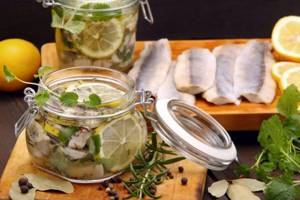
Drying the fish
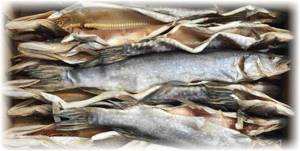
First of all, it is important to protect the product from insects; the main problem is flies. There is an opinion that for this it is better to hang the pike in the evening, when the flies are no longer active. By morning, the liquid on the surface of the fish and in the abdominal cavity will evaporate, and the flies will become uninterested in it. Other experts advise coating the carcass with vegetable oil or a vinegar solution; these measures will also get rid of unnecessary attention from insects. Subsequently, you will get dried pike without the larvae of annoying flies. The product should be dried by hanging it in a dry place with good ventilation at a temperature of 18 to 25 degrees. They hang the fish by the head, but you can also hang it by the tail, there is no big difference. The belly of the pike should be expanded by inserting toothpicks or twigs across it that can hold the edges. Dried pike will be obtained after 2-3 weeks, depending on the size. You need to dry the fish in the shade, avoiding direct sunlight. In the fall, the fish may not be completely dried outside and requires the process to be completed indoors near the radiator.
You can dry the fish by placing it in the oven. This method allows you to speed up the process and get results in less than a day. To dry the product in the oven, you need to put it in straw, this is done so that the fish does not burn on the baking sheet, otherwise it will spoil the taste of the pike. The straw needs to be periodically replaced with fresh straw. The main thing is to make sure that the pike’s head does not burn; to do this, you can wrap it in foil.
Dried fish can be stored for a very long time and will delight fish lovers in winter. The product does not require special conditions for storage and will lie perfectly in a cool, dark place.
vdomeeda.ru
Preparing pike for salting
The pike must first be gutted and prepared for subsequent procedures. Cut off the head, tail and fins.
If there are several pikes, then one head can be sacrificed. Let your husband or guys dry it so that you have something to brag about later. To do this, several matches are inserted into its mouth and placed on mummification. By the time guests arrive, it will already have time to become a small souvenir if it is varnished and glued to a wooden base.
Such a product will find its place not only in the kitchen, but also in the reception area, among other trophies or even just photographs from fishing.
But if no one wants to bother with making a souvenir, this “waste” would be quite appropriate for making fish soup.
But let's return to our pike a la salmon. All its insides should be removed, doing it very carefully. Under no circumstances should the gall bladder be damaged, otherwise the carcass will be completely ruined. If everything went well, we begin to remove the bones - the spine and ribs.
An incision on the back will allow the operation to be performed without much difficulty. In no case is it recommended to wash the fish - you need to wipe it dry with napkins. Prepared carcasses should be sprinkled with a special mixture.
It's quite simple:
- salt (coarsely ground) – 2 tablespoons;
- beet sugar (not cane sugar) – 1 tablespoon;
- ground (or freshly ground) black pepper.
You should generously rub pike carcasses with this simple mixture, but don’t be too zealous in “massaging” them from the inside. The salt should be coarse, because only in this case will the fish be “saturated” with it, starting from the skin and ending, in fact, with the meat.
If you use finely ground salt, you can only spoil the original product. The skin will become hard, and the pike meat will not be able to absorb the salt. Unfortunately, such a product will simply have to be thrown away.
When choosing a container in which the fish will be placed, it is worth considering the fact that there will still have to be oppression on top. Perhaps an ordinary glass jar is not quite suitable. The prepared dish should be placed in the refrigerator for two days so that it simmers there quietly and reaches the desired condition when it can be consumed with cold beer or vodka with friends or guests.
Step-by-step preparation
The process itself looks like this:
- Before salting fresh pike for drying, you need to thoroughly wash off the mucus from its skin and keep it cool for a couple of hours.
- Carcasses longer than 35 cm must be gutted, gills and caviar removed. At the same time, leave the head.
- Rinse the fish and season generously with salt. Pike is found in the river, so it often becomes a source of dangerous parasites. To be sure, you need to use more salt (200g/kg). This will prevent harm that the fish can cause. On carcasses weighing 1.5 kg or more, longitudinal cuts are made on the back with a sharp knife and filled with crystals.
- Now the fish is transferred to a container with the prepared salty mixture (only with the belly up). To one part salt there are 4 parts clean water.
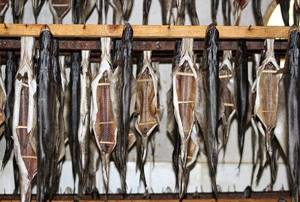
- Next, the containers are moved to a dark, cool place (at a temperature within + 15 - 20 degrees).
- Before drying fresh pike at home, you need to remember that large specimens will be salted for about five days, while smaller ones will need three. After this time, the fish is removed from the brine. Now it needs to be washed with water with the addition of acetic acid. After this, soak in clean fresh water. As soon as the pike floats to the surface, it needs to be removed and dried.
- The last step is stringing. You can hang it to dry by the tail (so the flesh is better saturated with fat) or by the head, threading the thread through the eye holes. Make sure that the carcasses do not touch closely to each other.
- Before drying salted pike at home, you need to choose a place in the open air under awnings or in well-ventilated areas. Periodically you need to check the readiness of the product. It will take more than a week to dry “to ram” in warm, windy weather.
Advice! If you add a little lemon juice to the brine, it will minimize the muddy aroma that pike smells of.
Dried pike in an electric dryer
Large specimens are very fatty, and it is very difficult to dry them entirely, and there is no need to, if you can prepare a delicious snack for beer.
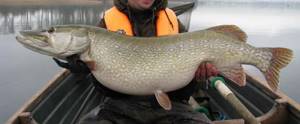
Clean the pike from scales, cut off the head and gut it. Take it apart into fillets and cut the fillets into thin strips.
- 1.5 liters of water;
- 5 tbsp. l. salt;
Heat until the salt dissolves. Add spices to taste to the warm marinade and soak the prepared pike strips for 5 hours.
Drain the marinade, cover the tray of the electric dryer with parchment paper, and place the fish pieces in it.
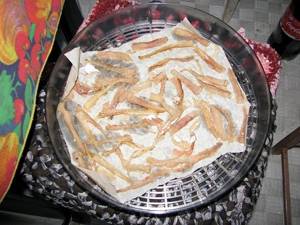
The Ezidri electric dryer sets the temperature at 60 degrees, and the drying time for pike is about 10 hours.

Taste it, keep in mind that you won’t eat it all at once, and it will dry out even more on its own.
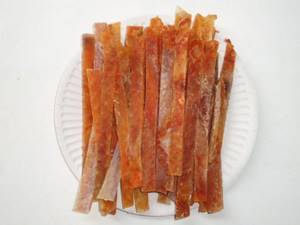
For more information about drying pike in an electric dryer, watch the video:
Drying fish: crucian carp and pike
Taranka for beer is loved not only by avid fishermen, but also by many lovers of a foamy drink who have never held a fishing rod in their hands. We present to your attention a step-by-step method on how to make taranka at home, ideally combined with beer: it has an excellent taste and aroma, contains the right amount of fat (not too dry), is moderately salted, and can be stored well without losing its properties.
Recipe for dried small pike
If in your fishing catch you brought a couple or three, or even a dozen pike, weighing up to a kilogram, it’s time to dry them, especially since the recipe for dried pike does not require much effort or complex manipulations. For super-fast cooking of small pike you will need the following products:
- small and medium-sized pikes - 3-4 pieces,
- salt - 4 tablespoons + a couple of handfuls,
- butter - 200 grams,
- straw - 1 bunch,
- rye bread crust - 100 grams.
- Number of servings: 3-4;
- Preparation time: 2-3 days.
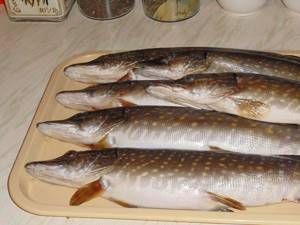
We cut up the pike: remove the scales, then cut along the backs and carefully remove the insides. We leave the belly intact, and you can make a couple of cuts along the back. We salt the pike with dry salting: rub it with salt inside and out and place it on a salt layer in a plastic or enamel container. We leave the fish to salt for two days. Then we wash each carcass with fresh cold water and send it to dry on towels.
We wipe each of the pikes, and then insert pieces of butter (50 grams per carcass) into the cuts on the back. Place straw on a baking sheet, and pike on top of the straw. You can wrap foil around the nose of the fish to prevent it from burning. We place crusts of rye bread around the pikes - they will give the fish a pleasant aroma, and put the baking sheet in the oven at a low temperature (about 110-120 degrees). The pike are dried for about 10 hours, and then the finished dried pike can be safely served.
Wet method
- Clean the pike from scales, gut it and cut it into pieces.
- Place the fish in a non-metallic container (enamel, glass, ceramic).
- Prepare the brine: add 100-150 g of salt to 1 liter of water. If the brine is prepared correctly, a raw chicken egg will not sink in it.
- Pour the prepared brine over the fish so that it is completely immersed in the liquid.
Do you like pike dishes?
- Yes 86%, 4064 votes
4064 votes 86%4064 votes - 86% of all votes
- No 10%, 491 votes
491 votes 10%
491 votes - 10% of all votes
- I don't eat fish 3%, 156 votes
156 votes 3%
156 votes - 3% of all votes
Total votes: 4711
18.06.2020
×
You or from your IP have already voted.
Cooking time:
After 3 days, the fish can be served, garnished with onion rings and poured with vegetable oil.
Amount of ingredients:
For a pike weighing 1 kg you will need about 1 liter of cold water and 150 g of salt. You can add 0.5 tsp to the brine. sugar, this will give a delicate taste to the salted fish.
KBJU 100 g of salted pike: 84 kcal, proteins 18.4 g, fats 1.1 g. No carbohydrates.
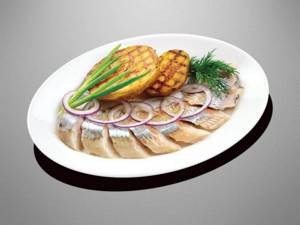
Salting recipes
On the Internet you can find many recipes to help salt fish, but not all of them help preserve the taste of the product, giving the meat the desired structure and maintaining fat content.
If the fish is supposed to be stored for a long time, then traditional methods are more suitable, but if the fish is supposed to be eaten immediately after cooking, then it is realistic to use spicy salting.
Dry (traditional) method
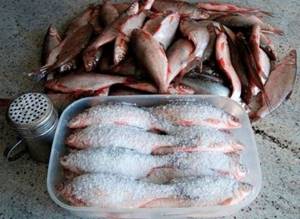
The traditional or classic method of salting is carried out in a deep container, with holes, made of wood. It is permissible to use a box made from ordinary boards as a container. You should also stock up on a linen bag, coarse rock salt, and fish (prepared).
The bag is placed on the bottom of the box, and then the fish is laid out and salted.
First of all, a centimeter layer of salt is poured onto the bottom of the container, and then the fish, while each fish is thoroughly rubbed with salt on all sides. The fish is placed so that there is as little free space as possible. After each layer laid in this way, the fish is sprinkled with a thin layer of salt. After the laying process is completed, the fish is also covered with a centimeter layer of salt on top. Finally, the fish is covered with a lid with a heavy weight, and the lid should put pressure on the fish, and not just cover the container.
On a note! If you crush the fish under pressure, then between the fish carcasses there will be no voids in which bacteria can develop. In addition, oppression makes the meat structure more dense.
In this state, the fish is left for a week and a half, in a cool, dark place. The juice that begins to secrete will come out through the holes.
At the end of the salting process, they begin the process of soaking the fish and further drying it.
Wet method or salting in brine
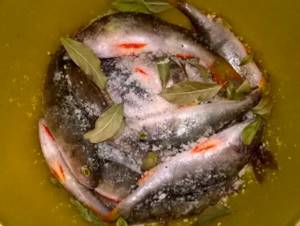
To do this, you will have to find a suitable container that does not support oxidation processes. A plastic bucket is suitable for this, but it must be made of food-grade plastic or an enamel bucket (saucepan), etc. After this, the fish is tightly placed in a container with its belly up and sprinkled with salt. For 10 kg of fish you will need 1 kg of salt.
On a note! If you add no more than 30 g of sugar for every kilogram of salt, the fish meat will taste more tender.
Just as in the first case, the fish should be pressed down with a lid with a weight (pressure). Somewhere on the 2nd day, the fish begins to release juice, which combines with salt. The result is a brine in which the fish will remain for up to 10 days, which depends on the size of the fish: the larger the carcasses, the more time is needed for them to be well saturated with the marinade.
After this period, the fish is taken out and washed in running water, after which the fish is ready for the next stage - the drying or drying stage.
Preparing brine is not difficult if you dissolve 1 kg of salt in 3 liters of water. After this, the fish is filled with the resulting brine and aged for up to 8 days. The fish, as in the first case, must be covered with oppression and placed in a cool place.
Spicy salting method
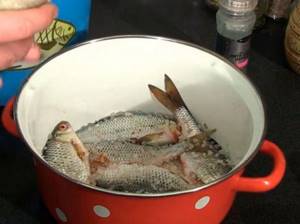
The correct salting process comes down to preparing the brine, as in the previous case, and then adding spices to it, in the form of bay leaves, black peppercorns, horseradish leaves and coriander (in any form). If you add a little sugar, it will not worsen the taste of the product.
The fish should be placed in an enamel container and filled with brine. Without fail, the fish is covered with oppression. After this, the fish is left for a couple of days.
After this process, it is better to dry the fish a little, which will increase the shelf life of the fish in the refrigerator, and will also allow you to get a brighter taste.
Hanging method
This salting method is mainly used for fatty fish. Fish carcasses are strung on a transverse rod through the gills and placed in a container with brine. Moreover, the fish should be in a suspended state. Water and salt are used as brine without adding other components. The amount of salt is determined as follows: a raw egg or potato is placed in the brine. If they do not sink, then the brine is of the required concentration.
The salting process lasts 4-6 days. Naturally, it is difficult to determine exactly how long it takes for the carcasses to be saturated with brine without gaining excess salt. As a result, many people overexpose their fish. As a result, the fish then has to be soaked, and longer than usual.
Salmon method for fresh fish
Mackerel or herring are usually salted in this way. Before salting, the fish is cut and generously sprinkled with salt around the belly, as well as on the back. It is better to add 10 grams of sugar and spices to the salt, in the form of bay leaves or black peppercorns. After this, the fish is wrapped in linen or cotton cloth, after which the fish is placed in the refrigerator.
After this, the fish is kept in the refrigerator for up to 30 hours, and then the fish is taken out and dried laid out on a flat surface. At the same time, some people begin to eat fish without drying it.
Steps
Let's start the process of preparing amazingly delicious pickled pike with vinegar and onions by preparing the fish. Don't use fish that has been frozen because no matter how hard you try, the meat will be watery
Be sure to wash fresh fish in running water and then remove small scales using a special scraper. Using a sharp knife, open the belly and carefully remove all the insides, being careful not to damage them. If the fish contains caviar, put it on a separate plate
Cut the carcass along the ridge and carefully remove the bones. Then rinse the resulting fillet and dry well with paper towels. The result will be the same beautiful carcass as in the photo.
Place the pike on a cutting board and use a sharp knife to divide the carcass into two parts, making a cut at the ridge. Cut the resulting parts crosswise into even strips one and a half to two centimeters wide.
Now you need to peel the onion and then place it in a bowl of cold water for a few minutes. This will remove any excess bitterness and wash away the esters that make people cry when grinding it.
After removing the onion from the water, dry the outside of it with paper towels and begin slicing it in half crosswise.
Cut the halves into beautiful half rings, as in the photo. READ ALSO: Cucumber variety Siberian Garland F1
Mix sugar and salt in a separate plate, and then pour them into a bowl with chopped pike. Using gentle movements of your fingers, rub them into the pieces.
Salt and sugar will dissolve, it will turn out as shown in the photo. We will place the salted fish pieces into a clean jar. Take the time to rinse the container in warm water with the addition of baking soda, rinse thoroughly in running water and hold over steam (or warm it up by filling one third with boiling water in the microwave at full power)
for five minutes.
To make the fish tasty and tender, be sure to layer it with onion half rings. The final piece should be the onion.
There is no need to compact the fish too much; just carefully arrange the pieces.
As a result of your efforts, you will receive the same beautiful jar of fish as in the photo. The final touch in preparing the pike delicacy will be pouring the laid fish with a mixture of 6% vinegar and deodorized vegetable oil. They must be brought to an emulsion state. This is very easy to do: shake the ingredients thoroughly several times in a separate tightly screwed jar or beat with an immersion blender until smooth.
Close the jar of fish tightly, shake it well and refrigerate for two days. But, if you so desire, you can easily store this preparation in the refrigerator all winter. To do this, place the fish in sterile jars and roll them up dry and clean (pre-boiled for two minutes)
lids.
You will always have a delicious appetizer in stock, and all that remains is to prepare boiled potatoes and a beautiful plate for the fish, on which you will need to place the fish along with the onions. Connoisseurs of the taste of lightly salted fish will be able to take a sample of delicious pickled pike with onions the very next morning
, and all other tasters will be able to enjoy the appetizer after 24 hours.
Bon appetit!
Preparing the fish
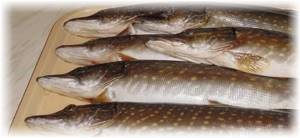
In order to dry pike at home, you need to properly prepare it. First of all, you need to take the fish and gut it, but you do not need to remove the scales, this is not necessary.
Salting
Then the gutted pike needs to be salted. The dry method is best suited for this, since it allows you to remove a certain amount of liquid from the pike already at this stage. You need to take enamel or plastic containers. Cover the bottom with a layer of coarse salt, place the fish and cover it again with a layer of salt. Salt should be placed evenly so that there is no accumulation of large amounts in one place. After this, you need to cover the product with a plate of suitable diameter and press it down with a heavy object to create a press.
After some time, liquid will begin to come out of the fish. There are several opinions about it. Some people advise constantly draining the liquid to ensure greater dehydration of the fish, while some, on the contrary, recommend leaving the product in the brine so that it is better salted.
Advice! It is important to remember that pike is a river fish; it may contain unwanted parasites that should not enter the human body. Therefore, it is important to salt the pike as best as possible. Professionals recommend salting pike using 200 grams of salt for every kilogram of fish.
The fish should be salted for 3-7 days, depending on the size of the individual. Professionals advise drying medium-sized specimens - this is the only criterion for selection. The weight of the fish before drying should be around a kilogram. Pike of this size will be well salted and dry optimally and will delight dry fish lovers throughout the winter.
Soaking
After the salted pike is removed from the brine, it should be washed in water with several tablespoons of acetic acid, and then soaked in water so that it releases excess salt. After the pike floats to the surface, it can be removed from the water and dried. In general, it is recommended to soak the product for as many hours as the days it was salted. Only after this can you start drying.
Wet salting of pikes
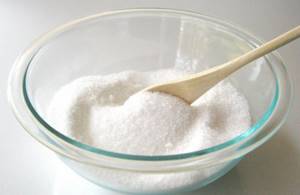
How to salt pike at home using the wet salting method? Let's try to figure it out.
First prepare the marinade. One liter of running water will require about six large spoons of salt. The solution is stirred well and heated a little to better dissolve the salt.
The prepared fish should be placed in a container and filled with brine. Under no circumstances should you use iron containers.
In this way, pike is salted for three days. Then you should taste the fish meat. If it is too salty, the carcasses are soaked in ordinary water for about an hour. Then put it on a beautiful plate and pour oil over it. In this form, salted pike can be served.
Pike cutting
First you need to prepare the fish for further salting.
Pike prepared for salting should not be washed with water; ordinary napkins should be used to clean the fish.
Small fish are most often salted together with the head and entrails, but since the pike will be larger in size than other fish, it will need to be gutted. Gutting a large pike is necessary because it may simply not be salted and its intestines will begin to rot, which in turn will lead to a deterioration in the taste of the snack, giving it a bitter taste.
When gutting pike, it is necessary to remove the gills (if salting is done along with the head) and carefully remove the insides, trying not to touch the gall bladder. There is no need to peel the scales from pike. When salting large fish, it is better to remove the head and tail.
If during gutting you find caviar, rinse it and place it in the belly of the already gutted fish. Pike caviar is considered a delicacy.
To better salt the pike meat, make a cut on the back.
If possible, remove the spine and large rib bones, as eating boneless fish is much more enjoyable.
Quick salting of pike

This recipe will tell you how to salt pike quickly and tasty. The following ingredients must be used:
- liter of drinking water;
- vinegar – 300 ml (apple vinegar is the best option);
- three tablespoons of coarse salt;
- three cloves of garlic;
- one spoon of sugar;
- favorite spices.
- Heat the water over the fire along with sugar, salt and spices (you can take black, allspice, coriander, bay and cloves).
- Grate the garlic and also add to the water with spices.
- When the water boils, add vinegar. Everything should be done with caution so that the vapors do not burn the respiratory tract.
- Next, the finished marinade is poured into a container with prepared pieces of pike. The fish will be salted for four hours. But it is better to leave it in this state for one day.
- Before serving, place the pike on a plate, pour over any oil and sprinkle with onions.
Dried or dried fish: what's the difference?
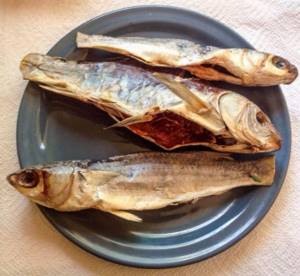
Few can give the correct answer to the question of how dried fish differs from dried fish.
In this case, in any case, the fish is salted and necessarily soaked. The drying process takes place in well-ventilated areas with access to sunlight. The drying process in this case is accompanied by complex physical and biochemical processes. In addition, dried fish is not a semi-finished product and can be eaten immediately without subjecting it to additional processing.
On a note! There are special dryers for drying fish, but in a pinch, a balcony will do.
As for dried fish, it is considered a semi-finished product and its consumption requires additional processing. All this is due to the fact that fish does not ripen during this process due to the nature of the process itself.
Although there are many ways to salt fish, you can only use one of the presented ones. Withering or drying fish at home is not difficult, just take water and salt. This is the simplest, classic method that does not require much time. In addition, a small fish does not require much preparation time. It is better to additionally steam salted fish (dried) before serving. As a side dish, boiled potatoes are suitable, which go well with any salted fish.
Secrets of delicious fish
The following tips will help you create delicious dishes:
- The amount of salt will depend on the weight of the carcass. The optimal proportion is at least 75 g per kilogram of product.
- Pike is low in calories. Under the influence of crystals in combination with fresh air and the rays of the sun, properly prepared pulp quickly thickens, becomes saturated with fat and acquires a special taste and aroma.
- The whole pike must be dried under a canopy.
- The value of dried fish is determined by the degree of fat content.
- The best time for such home cooking is autumn or summer.
- It is recommended to use enamel, wooden or plastic dishes for salting.
Note! Dried pike can also be made indoors. Often they use a balcony for this purpose or simply hang it outside the window. But today there are many special devices. Thus, housewives often carry out dehydration using an electronic dryer. It is also convenient to process fish in it, but for this it is better to cut it into thin strips or strips. Using an electric dryer, you can make snacks all year round. At the same time, it takes much less time for the fish to become dry.
